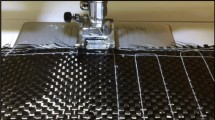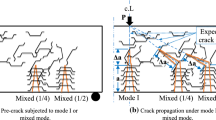Abstract
A sandwich three-point bend specimen has recently been proposed to test mode-I interlaminar fracture toughness for fiber-reinforced composite materials. The test composite consist of a thin layer bonded by two lateral reusable steel bars (Sohn et al. 1995). Some time earlier this specimen configuration was used to test fracture toughness of adhesives (Zdaniewsk et al. 1987). However, formulae for analysing its fracture mechanics parameters such as stress intensity factor and energy release rate can not be found in the literature. The lack of adequate formulae may explain why suitable quantitative analysis using this specimen configuration has not been achieved. In this paper, a simple and effective homogenisation method is used to change the bi-material system, which represents the specimen, into single uniform test material. This physical homogenisation is carried out by geometric change of the cross section of lateral steel parts based on equal deflection rigidity. For the transformed specimen configuration of single uniform material, the corresponding stress intensity factor solution from handbooks is available. Two formulae of stress intensity factor for the sandwich three-point bend specimen are given as upper limit and lower limit respectively, they are plotted with varying elastic tensile modulus mismatch. Then the relation between stress intensity factor and energy release rate, with special consideration of orthotropy of the tested composite material, is used to derive its energy release rate. The specimen and its formulae can also be applied to test other materials such as wood, welded joints (Burstow and Ainsworth, 1995), as well as to test dynamic fracture toughness.
Similar content being viewed by others
References
ASTM standard test method for mode I interlaminar fracture toughness of unidirectional continuous fiber reinforced composite materials. ASTM Standard D5528-94A, ASTM, Philadelphia, PA, 1994.
Burstow, M.C. and Ainsworth R.A. (1995). Comparison of analytical, numerical and experimental solutions to problems of deeply cracked welded loints in bending. Fatigue and Fracture of Engineering Materials and Structures 18, 221–234.
Fleck, N.A., Hutchinson, J.W. and Suo, Z. (1991). Crack path selection in brittle adhesive layer, International Journal of Solids and Structures 27, 1683–1703.
Gere, J.M. and Timoshenko, S.P. (1984). Mechanics of Materials, second edition, Wadsworth Inc., California, pp. 704–705.
Jain, L.K. and Mai, Y.W. (1994). On the equivalence of stress intensity and energy approaches in bridging analysis, Fatigue and Fracture of Engineering Materials and Structures 17, 339–350.
Sohn, Min-Seok and Hu, Xiao-Zhi (1995). Comparative study of dynamic and static delamination behaviour of carbon fiber epoxy composite laminates, Composite 26, 849–858.
Tada, H., Paris, P.C. and Irwin, G.R. (1985). The Stress Analysis of Cracks Handbook, Paris Production, Inc., Saint Louis, Missouri.
Ye, Lin (1992). Evaluation of mode-I interlaminar fracture toughness for fiber-reinforced composite materials, Composites Science and Technology 43, 49–54.
Zdaniewski, W.A., Cowway Jr., J.C., and Kirchner, H.P. (1987). Effect of joint thickness and residual properties of ceramic adhesive joints: II, experimental results, Journal of the American Ceramics Society 70, 110–118.
Author information
Authors and Affiliations
Rights and permissions
About this article
Cite this article
Wang, QZ. A sandwich three-point bend specimen for testing mode-I interlaminar fracture toughness for fiber-reinforced composite materials. International Journal of Fracture 85, 231–240 (1997). https://doi.org/10.1023/A:1007402000862
Issue Date:
DOI: https://doi.org/10.1023/A:1007402000862




